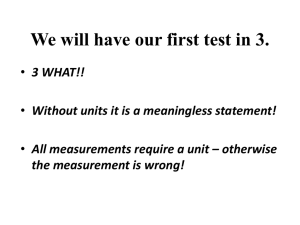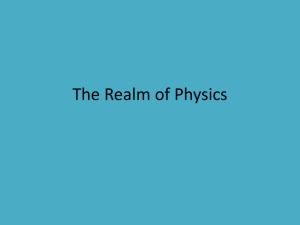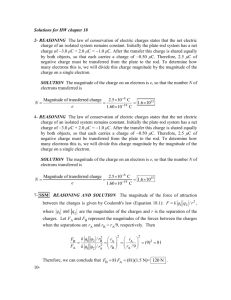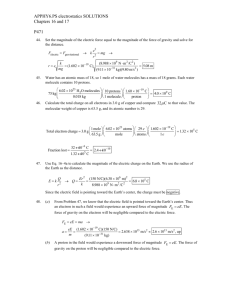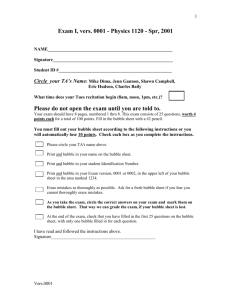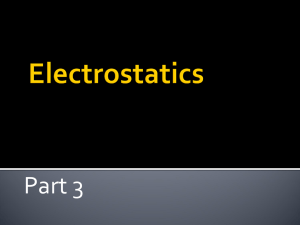Chapter22
advertisement
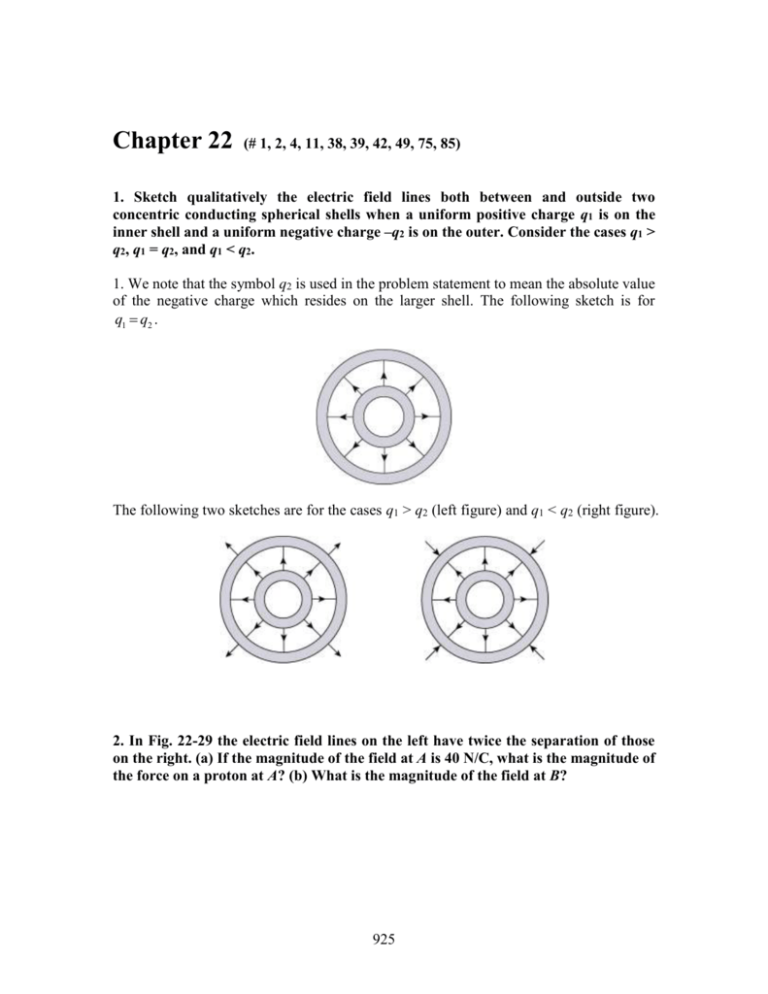
Chapter 22 (# 1, 2, 4, 11, 38, 39, 42, 49, 75, 85) 1. Sketch qualitatively the electric field lines both between and outside two concentric conducting spherical shells when a uniform positive charge q1 is on the inner shell and a uniform negative charge –q2 is on the outer. Consider the cases q1 > q2, q1 = q2, and q1 < q2. 1. We note that the symbol q2 is used in the problem statement to mean the absolute value of the negative charge which resides on the larger shell. The following sketch is for q1 q2 . The following two sketches are for the cases q1 > q2 (left figure) and q1 < q2 (right figure). 2. In Fig. 22-29 the electric field lines on the left have twice the separation of those on the right. (a) If the magnitude of the field at A is 40 N/C, what is the magnitude of the force on a proton at A? (b) What is the magnitude of the field at B? 925 926 CHAPTER 22 2. (a) We note that the electric field points leftward at both points. Using F q0 E , and orienting our x axis rightward (so î points right in the figure), we find G hF H IJ K N F 16 . 1019 C 40 i 6.4 1018 N i C c which means the magnitude of the force on the proton is 6.4 10–18 N and its direction (ˆi) is leftward. (b) As the discussion in §22-2 makes clear, the field strength is proportional to the “crowdedness” of the field lines. It is seen that the lines are twice as crowded at A than at B, so we conclude that EA = 2EB. Thus, EB = 20 N/C. 4. What is the magnitude of a point charge that would create an electric field of 1.00 N/C at points 1.00 m away? 4. We find the charge magnitude |q| from E = |q|/40r2: q 4 0 Er 2 1.00 N C 1.00 m 8.99 10 N m C 9 2 2 2 1.111010 C. 11. In Fig. 22-23, the four particles form a square of edge length a = 5.00 cm and have charges q1 = +10.0 nC, q2 = -20.0 nC, q3 = +20.0 nC, and q4 = -10.0 nC. In unitvector notation, what net electric field do the particles produce at the square’s center? 927 11. The x component of the electric field at the center of the square is given by | q3 | | q2 | | q4 | 1 | q1 | cos 45 2 2 2 4p 0 (a / 2) (a / 2) (a / 2) (a / 2) 2 1 1 1 | q1 | | q2 | | q3 | | q4 | 2 4p 0 a / 2 2 Ex 0. Similarly, the y component of the electric field is | q3 | | q1 | | q2 | | q4 | 1 cos 45 4 0 (a / 2) 2 (a / 2) 2 ( a / 2) 2 ( a / 2) 2 1 1 1 | q1 | | q2 | | q3 | | q4 | 2 4 0 a / 2 2 Ey 8.99 10 9 N m 2 / C2 (2.0 10 8 C) 1 1.02 105 N/C. 2 (0.050 m) / 2 2 ˆ Thus, the electric field at the center of the square is E E y ˆj (1.02 105 N/C)j. 38. Humid air breaks down (its molecules become ionized in an electric field of 3.0 × 106 N/C. In that field, what is the magnitude of the electrostatic force on (a) electron and (b) an ion with a single electron missing? 38. (a) Fe = Ee = (3.0 106 N/C)(1.6 10–19 C) = 4.8 10 – 13 N. (b) Fi = Eqion = Ee = 4.8 10 – 13 N. 928 CHAPTER 22 39. A charged cloud system produces an electric field in the air near Earth’s surface. A particle of charge -2.0 × 10-9 C is acted on by a downward electrostatic force of 3.0 × 10-6 N when placed in this field. (a) What is the magnitude of the electric field? What are the (b) magnitude and (c) direction of the electrostatic force Fel on the proton placed in this field? (d) What is the magnitude of the gravitational force Fg on the proton? (e) What is the ratio Fel/Fg in this case? 39. (a) The magnitude of the force on the particle is given by F = qE, where q is the magnitude of the charge carried by the particle and E is the magnitude of the electric field at the location of the particle. Thus, F 3.0 106 N E 15 . 103 N C. 9 q 2.0 10 C The force points downward and the charge is negative, so the field points upward. (b) The magnitude of the electrostatic force on a proton is Fel eE 1.60 1019 C 1.5 103 N C 2.4 1016 N. (c) A proton is positively charged, so the force is in the same direction as the field, upward. (d) The magnitude of the gravitational force on the proton is Fg mg 1.67 1027 kg 9.8 m s 2 1.6 10 26 N. The force is downward. (e) The ratio of the forces is Fel 2.4 1016 N 1.5 1010. 26 Fg 1.64 10 N 42. In Millikan’s experiment, an oil drop of radius 1.64 µm and density 0.851 g/cm3 is suspended in chamber C (Fig. 22-14) when a downward electric field of 1.92 × 105 N/C is applied. Find the charge on the drop, in terms of e. 42. When the drop is in equilibrium, the force of gravity is balanced by the force of the electric field: mg = qE, where m is the mass of the drop, q is the charge on the drop, and E is the magnitude of the electric field. The mass of the drop is given by m = (4/3)r3, where r is its radius and is its mass density. Thus, 929 4 1.64 106 m 851kg m mg 4r 3 g q E 3E 3 1.92 105 N C 3 3 9.8 m s 8.0 10 2 19 C and q/e = (8.0 10–19 C)/(1.60 10–19 C) = 5, or q 5e . 49. An electron enters a region of uniform electric field with an initial velocity of 40 km/s in the same direction as the electric field, which has magnitude E = 50 N/C. (a) What is the speed of the electron 1.5 ns after entering this region? (b) How far does the electron travel during the 1.5 ns interval? 49. (a) Due to the fact that the electron is negatively charged, then (as a consequence of Eq. 22-28 and Newton’s second law) the field E pointing in the same direction as the velocity leads to deceleration. Thus, with t = 1.5 109 s, we find eE v = vo |a| t = vo m t = 2.7 104 m/s . (b) The displacement is equal to the distance since the electron does not change its direction of motion. The field is uniform, which implies the acceleration is constant. Thus, d v v0 t 5.0 105 m. 2 75. A spherical water drop 1.20 µm in diameter is suspended in calm air due to a downward-directed atmospheric electric field of the gravitational force on the drop? (b) How many excess electrons does it have? 75. (a) Using the density of water ( = 1000 kg/m3), the weight mg of the spherical drop (of radius r = 6.0 10–7 m) is c W Vg 1000 kg m3 4 IJ9.8 m s h 8.87 10 6.0 10 mhc G c hF H3 K 7 3 2 15 N. (b) Vertical equilibrium of forces leads to mg = qE = neE, which we solve for n, the number of excess electrons: n mg 8.87 1015 N 120. eE 1.60 1019 C 462 N C c hb g 930 CHAPTER 22 85. In Fig. 22-63, particle 1 of charge q1 = 1.00 pC and particle 2 of charge q2 = -2.00 pC are fixed at a distance d = 5.00 cm apart. In unit-vector notation, what is the net electric field at points (a) A, (b) B, and (c) C? (d) Sketch the electric field lines. 85. (a) Since E points down and we need an upward electric force (to cancel the downward pull of gravity), then we require the charge of the sphere to be negative. The magnitude of the charge is found by working with the absolute value of Eq. 22-28: | q | F mg 4.4N 0.029C , E E 150 N C or q 0.029 C. (b) The feasibility of this experiment may be studied by using Eq. 22-3 (using k for 1/40). We have E k | q | / r 2 with 4 sulfur r 3 msphere 3 Since the mass of the sphere is 4.4/9.8 0.45 kg and the density of sulfur is about 2.1 103 kg/m3 (see Appendix F), then we obtain F3m IJ 0.037 m E k q 2 10 rG r H4 K 13 sphere 11 2 sulfur which is much too large a field to maintain in air. N C




